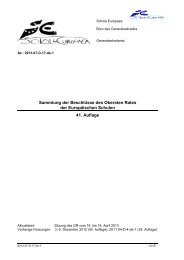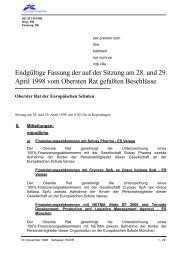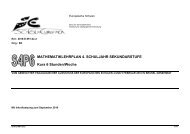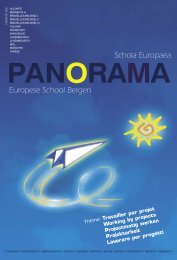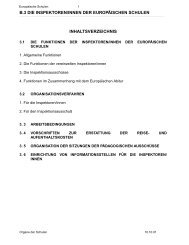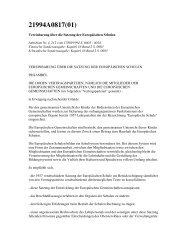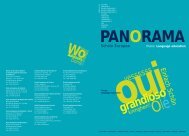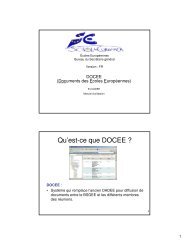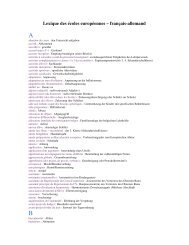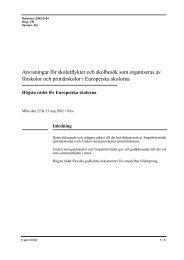External Evaluation of the European Baccalaureate (Annexes)
External Evaluation of the European Baccalaureate (Annexes)
External Evaluation of the European Baccalaureate (Annexes)
You also want an ePaper? Increase the reach of your titles
YUMPU automatically turns print PDFs into web optimized ePapers that Google loves.
Page <strong>of</strong> 216<br />
candidates choose one question from each section.<br />
P addresses section 7.1 <strong>of</strong> <strong>the</strong> syllabus covering cell membranes<br />
and energetics. G addresses section 7.2 covering genetics. E<br />
addresses section 7.3 covering evolution.<br />
Each question is subdivided into part questions. Some <strong>of</strong> <strong>the</strong>se<br />
are simple recall questions; some involve drawing labelled<br />
drawings or constructing genetic diagrams. Some questions<br />
involve data analysis and interpretation.<br />
Candidates are not required to write discursive essays.<br />
The mark scheme gives solutions to <strong>the</strong> questions and suitable<br />
answers. The mark scheme is not a point mark scheme with<br />
marking points clearly indicated and separated from each o<strong>the</strong>r. In<br />
some cases two answers are required, but three marks are<br />
allocated. It is not clear how <strong>the</strong> three marks are applied.<br />
There is no mention <strong>of</strong> marks for quality <strong>of</strong> written communication<br />
in <strong>the</strong> mark schemes.<br />
The ‘A’ mark is aggregated with <strong>the</strong> marks for <strong>the</strong> ‘Pre-Bac’ and<br />
<strong>the</strong> ‘Bac’ to give a mark that contributes towards a final total out <strong>of</strong><br />
100 for <strong>the</strong> <strong>European</strong> <strong>Baccalaureate</strong>.<br />
The information provided does not mention opportunities for resitting<br />
before certification.<br />
208<br />
By contrast, <strong>the</strong> Bac exam has a very large component <strong>of</strong><br />
interpretation data and is much more demanding in terms <strong>of</strong> higher<br />
level thinking.<br />
All answers are marked and <strong>the</strong> best combination which fulfils <strong>the</strong><br />
rubric is awarded.<br />
In Section A excess wrong answers cancel correct answers.<br />
A unit mark <strong>of</strong> 3 per point is <strong>the</strong> norm but exceptions are fairly<br />
common.<br />
The marking scheme is rigid and <strong>the</strong>re is little scope for individual<br />
interpretation, except possibly in diagrams and even <strong>the</strong>n <strong>the</strong>re are<br />
tight guidelines.<br />
Diagrams are usually given 6 marks if correct, 3 if one major part is<br />
missing and 0 if more than one major part is missing.<br />
Labels are marked without taking this diagram mark into<br />
consideration. For example, in T.S. <strong>of</strong> artery, three-layers/small<br />
lumen gets [6] marks, one layer missing gets [3] and two missing<br />
gets [0].<br />
`Initially, a sample <strong>of</strong> 20 papers is taken at random from <strong>the</strong> markers<br />
bundle <strong>of</strong> scripts and marked according to <strong>the</strong> marking scheme and<br />
<strong>the</strong>n sent to <strong>the</strong> advising examiner for checking. After this<br />
clarifications and modifications are given and all papers have to be<br />
re-marked. This is done so as to achieve uniformity <strong>of</strong> marking.<br />
About 5-10% <strong>of</strong> each examiner’s scripts are checked by an advising<br />
examiner.<br />
Appeals are allowed. Following <strong>the</strong> publication <strong>of</strong> <strong>the</strong> results, each<br />
pupil may examine his/her paper and decide whe<strong>the</strong>r or not to<br />
appeal.<br />
Appeals (usually about 20% per marker) are remarked by a different<br />
examiner and <strong>the</strong>n forwarded to <strong>the</strong> advising examiner. If <strong>the</strong>re is<br />
any change <strong>the</strong> paper is marked afresh by <strong>the</strong> advising examiner.<br />
A fur<strong>the</strong>r appeal may be made to <strong>the</strong> State Examination<br />
Commission.



